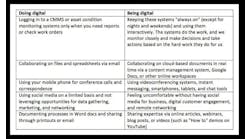In late October in a letter to customers, GE Digital CEO Pat Byrne announced that they were bringing several software businesses into the GE Digital fold: Grid Software, Power Digital, the Oil and Gas digital team, and the existing GE Digital business, including manufacturing execution and automation software, Predix products and digital transformation projects.
GE Digital's Pat Byrne
This move, according to GE Digital, makes it one of the largest industrial-software companies in the market with more than $1B in annual revenues. “Our mission is to bring simplicity, speed and scale to your digital transformation with software that helps you to better operate, analyze and optimize your business processes,” wrote Byrne, who noted that GE Digital’s primary focus is to provide industrial software and services in four key markets:
- Electric utilities & telecommunication
- Power generation (gas, steam, and related plant operations and service support)
- Oil & gas industry and related adjacent markets
- Select manufacturing applications and digital transformation projects
We wanted to learn more, so we connected with Pat. Take a look…
Smart Industry: What is the rationale behind aggregating software businesses within GE Digital?
Pat: In doing this we are generating a scale advantage to help our customers. We also have the ability to build these centers of competency with our deep domain expertise. That’s a major advantage for us. We’re not just a general software company; we know a lot about turbines and how a grid is operated. An advantage for customers is our ability to deploy at the point of impact.
A big barrier of the IoT is customer readiness as they go through business transformation. In order to be successful they need to bridge from their current state to their future state. We provide that through our implementation services. And we can do it globally.
We hear from customers who have this vision of digital transformation at the top of the organization, but there are gaps in their ability to take their current operations and enable transformation. That can be the difference between success and failure.
Smart Industry: Why these four markets?
Pat: When competing in these markets we are looking for strategic density—where can we bring an advantageous position. The other part is that these are good growth markets; the business outcomes are powerful.
With the manufacturing market, for example, we believe we have an advantageous position with our MES platform for process-oriented industries—CPG, food & beverage. The assets that have to be supported are assets that we know a lot about. And these are places where customers have an appetite and a budget for digital transformation at high-priority, key levels.
Smart Industry: Let’s take a step. Where do you see GE Digital’s role in the larger concept of digital transformation?
Pat: We are one of the largest scale, serious industrial incumbents with deep insights into operating, analyzing and optimizing the assets in these markets. We are not trying to sell our products to support every industry—we’re not in banking or building. We are focused on industry.
Smart Industry: How is digitalization changing as it matures?
Pat: Let’s use a baseball analogy—we’re in the early innings in industrial environments. If you look at it from the customer point of view, the operational capabilities inside most are pretty immature. If you ask them “Who is your CDO?” or “What is your governance model for industrial databases?” they are still pretty early on.
The good news is that, compared to seven or eight years ago, everybody now is having this conversation. I have yet to talk to a customer (even the most modest operators) who aren’t thinking about how to use digital technology to transform their operations. People are past the pilot phase. They are putting organization into place and trying to figure out how to scale efforts. Of course, there are also people struggling with that—trying to understand all the complexity after the pilot phase.
Smart Industry: You distributed that letter at your 100th day in your new role. What has surprised you?
Pat: I am very optimistic about this—the fact that people are really serious about digital transformation. The talent and technology in our global base is outstanding. Customers want to engage with us. On the competitive landscape there are plenty of competitors, but I like our chances.
What surprised me was that industry wasn’t further along. I thought we’d see more pervasive deployments. I thought at this point everybody would be scaling efforts, but we’re not there yet.
When people struggle, it’s not about the technology. It’s about customer readiness. It’s about enabling customers’ capabilities in using these tools. That’s what we are focused on in 2020. Industrial customers are looking for hard ROIs—here is how to generate a business outcome.



